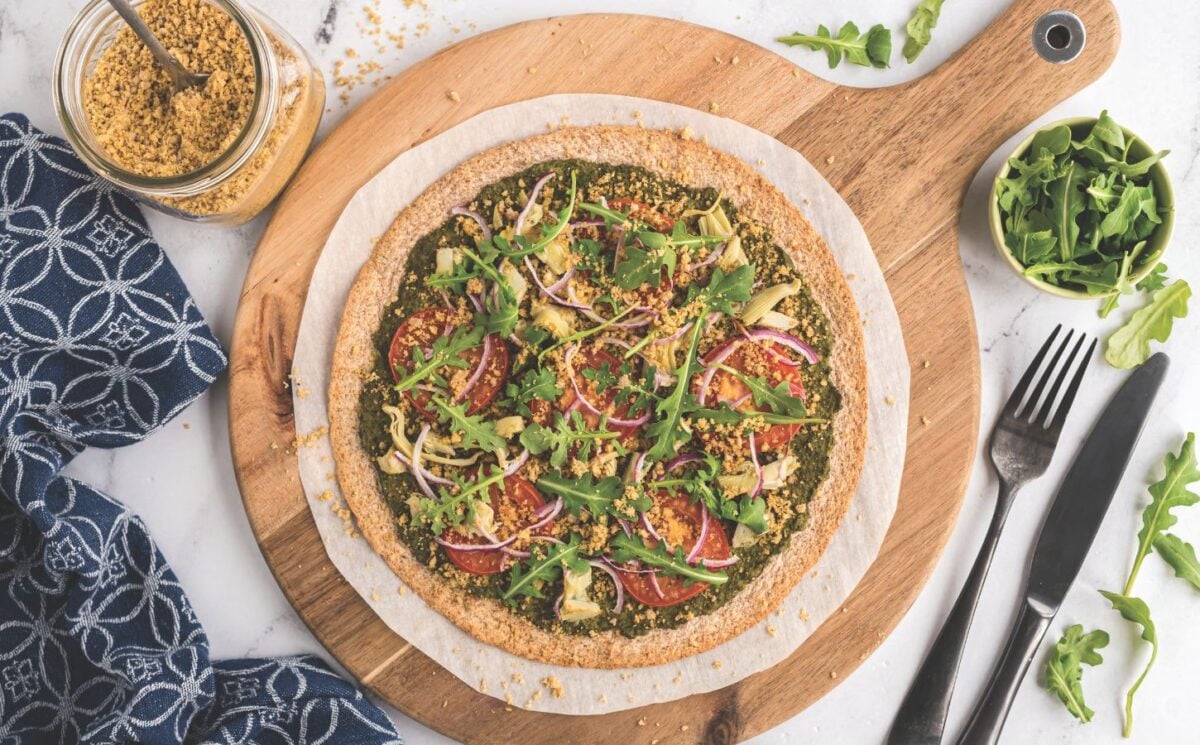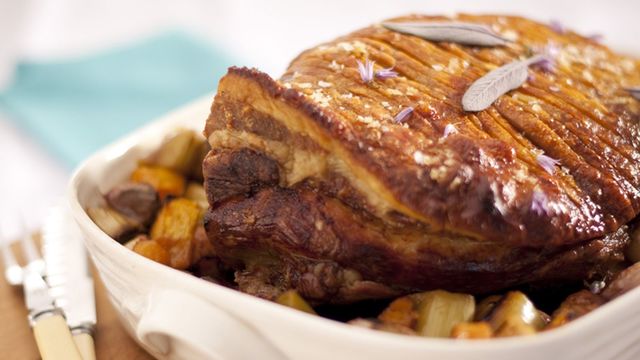
There are a lot of things you can do with applesauce. People have been using it not just as an accompaniment to their meals, but as an interesting addition to everything from boxed pancakes to store-bought mayonnaise as a way to improve their texture and flavor. Where people often struggle, though, is how to make applesauce more interesting in itself.
With such a recognizable and easygoing flavor, it can feel tempting not to mess with this sauce to avoid inadvertently ruining it. Well, folks, we're here to tell you that it's time to be brave. There are countless ways to enliven your applesauce, from the way that you prepare it to the ingredients you add, which make this food more than the sum of its parts.
Various ingredients can add spice, smoothness, warmth, and extra depth, which can all make your applesauce taste much richer. Opting for a different cooking method, meanwhile, can not just make it taste better, but it can cut out a lot of the hard work of making it. It's time to stop putting up with substandard applesauce, and to start employing these ingenious upgrades.
1. Infuse your applesauce with aromatic spices While some applesauces can have a hint of spice, usually from the addition of cinnamon, it's rare that spiciness is front and center with this dish's flavor profile. Next time you make it, though, we recommend taking a different approach.
The sprightliness of this applesauce is practically begging to be made more complex with extra spices, and throwing in aromatics like cloves, allspice, cardamom, and (of course) a generous pinch of cinnamon can give it more warmth. This warmth doesn't distract from the sharpness of applesauce either, but instead balances it out in an exciting way. Adding extra spices is easiest if you're making your applesauce from scratch , but if you're using store-bought applesauce you can still spice things up.
Pour it into a pot, add whichever spices you choose, and then bring it to a simmer. Allow it to cook for a few minutes so that the spices can release their oils and infuse the sauce with their scent and flavor. If you're using whole spices, it may be best to fry them in a little bit of butter before adding your applesauce to really unlock their flavors.
2. Leave your apples unpeeled Even when you have a chunky applesauce, each bite goes down easily with barely any resistance. Well, while this can be a big draw, it can also get super boring.
Sometimes we just want something with a little more bite to it, and an applesauce that feels like it has an identity instead of an anonymous, bland bowl of sugary purée. One of the best ways to make things more interesting also cuts out an annoying step when making applesauce: Just don't peel your apples. By skipping the peeling process you leave your applesauce with more bite, with the skin giving each mouthful a pleasing chewiness.
You also keep your applesauce looking a lot more colorful, cutting through the beige mass with streaks of green or red. The way that you process your applesauce will have a big effect on how much your apple skins stand out. If you're making a blended applesauce, your food processor will break down the skins too, and you'll just get the odd chew here and there.
If you're mashing it with a potato peeler , though, the skins will provide much more bite. 3. Mix it up with pears What's the main ingredient of applesauce? Spoiler alert: It's apples.
The clue's in the name, and that same name stops us from wanting to add anything else to it for fear of messing things up. However, using different fruits in your applesauce is a quick way to make it taste better and far more interesting — and for an addition that won't alter its consistency or flavor beyond recognition, go for pears. Pear flesh has a similar texture and color to apples, which lends it perfectly to being cubed up and popped in alongside them.
The combination of apples and pears also deepens the flavor of your sauce. Pears have a slightly gentler flavor than apples, with a mild, sweet aroma and taste that offsets the sharpness of more sour apple varieties. You don't have to stop there, either; try using quince in your applesauce.
This apple-like fruit has a tartness to it that brings a lot of brightness to applesauce, and as a pome fruit it has a similar texture to both apples and pears. You may have to add a little extra sugar to offset the sourness of the quince, though. 4.
Add some heat with cayenne pepper There's no reason why you can't add heat to applesauce , and doing so can make it an exciting side dish. A dash or two of cayenne pepper adds a subtle but identifiable heat, which cuts through its sugariness and adds a huge amount of complexity. The spicy pepperiness of the cayenne somehow elevates the sweet notes of the sauce, making it punchier and more exciting to serve alongside milder-flavored meats like pork.
Cayenne pepper isn't the only thing you can add for heat, either. A dash of chili flakes will have a similar effect and provide a slightly more direct heat, while chili powder will really bring the fire. If you're so inclined, you can even add fresh chiles into the mix.
Just chop them up and simmer them alongside your apples, allowing them to release a brighter, fresher fieriness. With hot ingredients, though, less is really more. Add just a little bit too much, and you'll make your applesauce impossible to eat.
It's also important to remember that spice develops over time, so give your cayenne pepper or whatever ingredient you're using a little while to release its heat before taste-testing. 5. Pour in a different sweetener The standard sweetener in applesauce is white sugar, and it's pretty clear why.
White sugar is not only cheap and available everywhere, but it's an effective way to make your applesauce very sweet, very quickly, without confusing your dish with other flavors. However, if you fail to consider a different sweetener, you fail to consider how you might make your applesauce more interesting. Alternative sweeteners can unlock floral or caramel-like notes and turn it from a simple side dish into something more multi-layered.
Adding maple syrup to applesauce is a great way to achieve a better aroma and more depth. Maple syrup has a fruity scent that complements the apples, paired with an almost toffee-like flavor that adds sophistication to the sauce. Honey will also add a slightly flowery scent and a sweetness that has layers of depth.
If you want to punch things up even more, try adding a deeper-colored sweetener like molasses or golden syrup. The darker you go, the more caramel-like your applesauce's flavor will become. Remember, though, that a darker syrup will result in a darker sauce.
6. Melt in some butter to amp up its smoothness Applesauce is renowned as a baking substitute that allows you to keep your food moist while reducing your baked goods' fat levels. However, this fat-free side dish benefits enormously from a little bit of butter.
Adding butter to applesauce gives it a richness that rounds out its flavor enormously. The fats in the butter help to reduce the toothache-inducing sweetness that a lot of applesauces have, and instead make the dish more mellow and creamy. If you're making homemade applesauce, adding butter to it is as simple as topping it with a spoonful of soft or melted butter before you serve.
You can do exactly the same thing with store-bought applesauce, too. However, it's worth keeping in mind that adding butter to applesauce may seem simple, but it can be tricky to get just right. Make sure you're using unsalted butter, as the salted variety will season your applesauce in a way that you likely won't want.
Don't add too much either, as this will make your finished dish greasy. Finally, you should only add butter if you're planning on serving it hot. If it cools it will start to firm up, and you'll end up with applesauce threaded with lumps of coagulated fat.
7. Garnish your applesauce with dried fruits The beige, consistent color of applesauce is practically begging for a pop of contrast on top of it — and you can add that contrast in a way that also adds flavor and texture. Our favorite way to garnish applesauce is with dried fruits.
Scattering your applesauce with a handful of raisins, sultanas, or dried cranberries gives it a splash of color, and the chewiness of the fruit cuts through the smoothness of the sauce. Adding dried cranberries will give your applesauce a pleasing tartness too, while raisins will contribute to its sweetness and deliver a slightly malty flavor. In truth, though, almost any dried fruit will improve your applesauce.
Opt for something more sprightly and add dried apricots, give your sauce a deeper flavor note with dried prunes, or go for the syrupy chew of figs. Plus, you don't have to stick with what you find in your store; you can make your own dried fruit at home and use up of produce that's past its prime. 8.
Give it a dash of apple cider vinegar Applesauce's sweetness can be a little much sometimes. The simplicity of this side dish is why it works, but it can also end up just tasting too simple to truly provide impact at the dinner table. The easiest way to add layers of flavor is with acidity, and the secret ingredient you need is apple cider vinegar .
Apple cider vinegar (or ACV) gives applesauce a pop of sourness that prevents it from tasting too syrupy, and adds an extra dimension to its flavor profile. Using ACV also gives your applesauce a slightly fruitier aroma — and the fact that it's made of apples means that there are no odd flavors introduced that can distract from the sauce itself. It's good to keep it in the family, right? If you don't have any ACV on hand, there are lots of different ways to add acidity to applesauce.
A tablespoon or two of lemon or lime juice will add a fresh-tasting tartness that has a fruity undertone. White wine vinegar and rice vinegar can also add acidic notes without clouding up the flavor. However, if you're adding acid you might want to bear in mind the type of apples you're using and how tart they are to begin with.
If you're working with a particularly sour variety, adding vinegar or citrus may make things overly acidic. 9. Stir in some chopped nuts Applesauce is rarely crunchy.
If the sauce does have any resistance in each bite, it'll be down to the chunks of apples, which are usually cooked enough to be soft and easily chewable. However, there are times where all you want is a bit more texture in your applesauce — and when you do, adding chopped nuts is the quickest way to introduce a better mouthfeel. You may want to avoid adding just any old nuts you can find, though.
While they can provide a pleasant crunch, you don't want too much going on in your sauce, and using harder varieties like almonds can be both distracting and get in the way of the sauce itself. It's best to go for softer nuts like walnuts, which provide resistance without the risk of you cracking your teeth on them. Walnuts also give your applesauce an added richness and a gentle nutty flavor.
Chopped cashews, pecans, and macadamias can also be good options, thanks to their relative softness and buttery flavors. If you want to give your nuts even more punch, toast them quickly in a pan before chopping them up and adding them to your applesauce. 10.
Pour in some alcohol for extra warmth When it comes to cooking, a lot of things are improved by a splash of alcohol — and applesauce is no different. A dash of booze is an awesome addition if you're making applesauce for a Thanksgiving or Christmas meal, thanks to the added luxury it gives it. The key benefit of adding alcohol is the warmth it provides.
Cognac, whiskey, and apple brandy can all infuse your sauce with rich, oaky flavors that balance out the sweetness in the sauce and make it even better to pair with meat. Aside from the flavor notes that these alcohols provide, the alcohol itself can also intensify the flavors in your applesauce, giving it an added depth and punch. While it's especially effective in spiced applesauces, it can do the same thing in the simplest recipes.
It's best to add your chosen alcohol while your applesauce is still cooking, to allow the excess alcohol to burn off. If not, the finished dish will taste acrid and burn your throat as you eat it. Naturally, failing to burn off the alcohol will also make your applesauce alcoholic — and not only will this make it unsuitable for kids, but we're also willing to bet that you don't want to get drunk from the meal you're eating.
11. A splash of vanilla will work wonders Applesauce is a deeply comforting dish, and so it's understandable that people don't want to mess with its base flavors too much. Adding vanilla, however, helps the sauce lean into those comforting notes without being too much of a distraction.
Both the flavor and the scent of vanilla helps to enhance applesauce and assists in rounding out the fruity notes in the sauce, making it simultaneously more floral and warmer. It also helps pull back some of the more sour notes, which can be particularly useful if your recipe is lower on sugar or you're using tart apples. Importantly, vanilla can be seriously overpowering if you add too much of it.
What's normally a background flavor can be turned into the predominant taste in the sauce, and vanilla extract can also add a bitterness to applesauce, which you definitely don't want. It's therefore best to stay on the safe side when adding your vanilla extract, and only put in a drop or two at a time. You'll be surprised at how much impact a tiny amount has.
12. Oven bake your applesauce to develop its flavor Applesauce is generally simmered in a pan before being puréed. While this method is tried and tested, it also doesn't necessarily develop the maximum amount of flavor possible.
Boiling the apples in water doesn't give them any potential to brown, and you're left with a fairly simple-tasting sauce. However, oven baking your applesauce opens up a whole new world of flavors. This slower cooking method involves popping your apples in a Dutch oven with just a bit of orange and lemon juice for moisture, and putting the mixture in to bake for approximately 90 minutes.
This gentle process allows the apples to break down gently, letting the natural sugars mingle with the sugar added to the recipe, which results in a caramelized end product that has deep, toffee-esque flavors. As your apples cook, they'll also catch on the side of the pot, leaving you with delightful browned bits that give your sauce even more nuance. Oven baked applesauce is covered as it cooks, which helps the apples break down and prevents them from drying out.
However, uncovering it towards the end of the cooking process will help its color develop even further. Just make sure you don't uncover it too early, as this will cause it to lose too much moisture. 13.
Orange zest will add fruitiness to your applesauce The balance of sweetness to tartness is what makes applesauce so appealing, but adding acid to generate tartness can sometimes overwhelm the dish. To create a sense of sourness while also giving your applesauce a perfumed edge, add orange zest. Orange zest will fill your sauce with the bright, fresh flavor of oranges without making it overly tart, thanks to the orange oils held in the fruit's skin being released.
Crucially, orange zest won't water down your sauce too much either, so you'll get that flavor without having to worry about it being too loose. For a slightly more citrusy edge, go for lemon or lime zest. If you want to make your applesauce really special, grapefruit zest can give the dish a deeply floral scent without too much of the bitterness of the fruit juice.
While the juice of whichever fruit you're zesting can help round things out, using just the zest itself will still have a big impact. 14. Add in some berries At what point does applesauce stop being applesauce, and instead turns into a sauce that has apples in it? There's an argument to be made that adding berries to the dish takes it too far away from its roots — but honestly, once you've tried it, you'll never go back.
Including berries in your applesauce recipe gives it a brightness that's sometimes lost in the cooking process. If you're unsure where to start, blueberry applesauce is a good entry point. Blueberries give your applesauce a deep sweetness and an acidic edge, and dye the sauce a blue-pink color that sets it apart.
Strawberries will also work excellently, with their sweet-sour flavor brightening it up. Just remember that any berries you add may cause things to get a little sweeter, so you may need to pull back on the amount of sugar you're adding..














